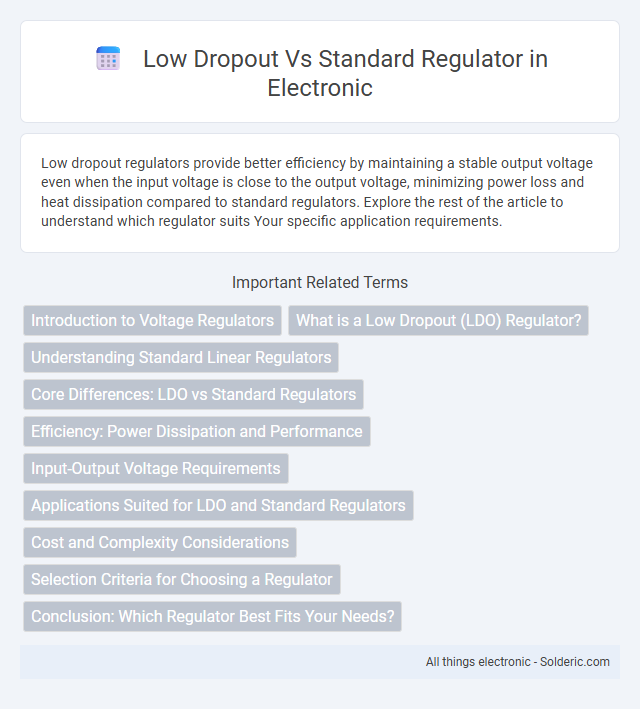Low dropout regulators provide better efficiency by maintaining a stable output voltage even when the input voltage is close to the output voltage, minimizing power loss and heat dissipation compared to standard regulators. Explore the rest of the article to understand which regulator suits Your specific application requirements.
Comparison Table
| Feature | Low Dropout Regulator (LDO) | Standard Regulator |
|---|---|---|
| Dropout Voltage | Very low (typically < 0.3V) | Higher (usually 1.5V to 2V) |
| Input Voltage Range | Close to output voltage, minimal difference needed | Requires higher input voltage above output |
| Efficiency | Higher efficiency at low voltage differentials | Lower efficiency due to larger voltage drop |
| Heat Dissipation | Reduced heat generation | More heat due to higher dropout voltage |
| Application | Battery-powered devices, low voltage circuits | General-purpose voltage regulation |
| Cost | Typically higher due to design complexity | Lower cost, simpler design |
| Response Time | Faster transient response | Slower response |
Introduction to Voltage Regulators
Voltage regulators maintain constant output voltage levels despite variations in input voltage or load conditions, ensuring stable performance for electronic devices. Low Dropout Regulators (LDOs) offer a smaller voltage differential between input and output, enabling efficient operation with low input voltage overhead. Standard regulators typically require a higher input voltage above the output level, which can result in increased power dissipation and reduced efficiency in low-voltage applications.
What is a Low Dropout (LDO) Regulator?
A Low Dropout (LDO) regulator is a voltage regulator designed to operate with a very small difference between input and output voltage, typically less than 0.3 volts, ensuring efficient power management in low-voltage applications. Unlike standard regulators, LDOs provide cleaner output with reduced noise and better transient response, which is crucial for sensitive electronic devices. Your choice of regulator impacts battery life and thermal performance, making LDOs ideal for portable and low-power systems.
Understanding Standard Linear Regulators
Standard linear regulators provide a simple and cost-effective means of voltage regulation by maintaining a constant output voltage despite variations in input voltage or load conditions. These regulators typically require an input voltage at least 2 volts higher than the desired output voltage to function properly, known as the dropout voltage. While they offer stable and low-noise outputs suitable for many applications, their efficiency drops significantly when the input voltage is much higher than the output, resulting in increased heat dissipation.
Core Differences: LDO vs Standard Regulators
Low Dropout (LDO) regulators maintain output voltage with a minimal voltage difference between input and output, typically below 0.3V, ensuring efficient power management in low-voltage applications. Standard regulators require a higher input-to-output voltage differential, resulting in increased power dissipation and reduced efficiency in battery-powered or low-voltage scenarios. The core difference lies in LDO's ability to provide stable, low-noise output closer to the input voltage, while standard regulators excel in high voltage-drop conditions but with greater energy loss.
Efficiency: Power Dissipation and Performance
Low Dropout (LDO) regulators offer higher efficiency compared to standard regulators by operating with a minimal voltage difference between input and output, which reduces power dissipation significantly. Standard regulators typically experience greater power loss due to a larger voltage drop, leading to increased heat generation and lower overall performance efficiency. This efficiency difference makes LDOs ideal for battery-powered and low-voltage applications where power conservation and thermal management are critical.
Input-Output Voltage Requirements
Low dropout regulators (LDOs) operate efficiently with a minimal voltage difference, typically around 0.1 to 0.3 volts between input and output, making them ideal for low input-output voltage differentials. Standard linear regulators require a larger voltage drop, often around 2 volts or more, limiting their use in applications where power efficiency and battery life are critical. The choice between LDOs and standard regulators hinges on the specific input-output voltage requirements and the need to minimize power loss in sensitive electronic circuits.
Applications Suited for LDO and Standard Regulators
Low Dropout (LDO) regulators excel in applications requiring clean, stable voltage with minimal noise, such as in battery-powered devices, portable electronics, and precision analog circuits. Standard linear regulators are better suited for applications where efficiency is less critical and the voltage difference between input and output is significant, like in power supplies for industrial equipment or microcontrollers with ample voltage headroom. Your choice depends on whether low noise and low dropout voltage are priorities or if simple, robust regulation with higher dropout voltage is sufficient.
Cost and Complexity Considerations
Low dropout (LDO) regulators generally incur higher costs due to the specialized semiconductor processes required to achieve low dropout voltages, making them more complex in design compared to standard linear regulators. Standard regulators offer simpler architectures and lower component counts, which reduce both manufacturing costs and design complexity, making them ideal for cost-sensitive applications. However, the improved efficiency and reduced heat dissipation of LDO regulators can offset initial expenses by minimizing the need for bulky heat sinks and extensive PCB layouts.
Selection Criteria for Choosing a Regulator
When selecting a voltage regulator, key criteria include dropout voltage, load current capacity, thermal performance, and efficiency. Low dropout regulators are ideal for applications requiring minimal voltage differential between input and output, ensuring better battery life or power savings in your design. Standard regulators may suffice where higher dropout tolerance and lower cost are priorities, but your choice should align with the specific voltage, current, and thermal requirements of your circuit.
Conclusion: Which Regulator Best Fits Your Needs?
Low dropout (LDO) regulators offer superior efficiency and stable output voltage at low input-output differentials, ideal for battery-powered or low-voltage applications, while standard regulators provide robust performance with simpler design and typically lower cost. Your choice depends on specific requirements such as power efficiency, thermal considerations, and voltage tolerance. Carefully evaluating these factors ensures the regulator you select aligns perfectly with your circuit's demands and operational conditions.
Low Dropout vs Standard Regulator Infographic

 solderic.com
solderic.com